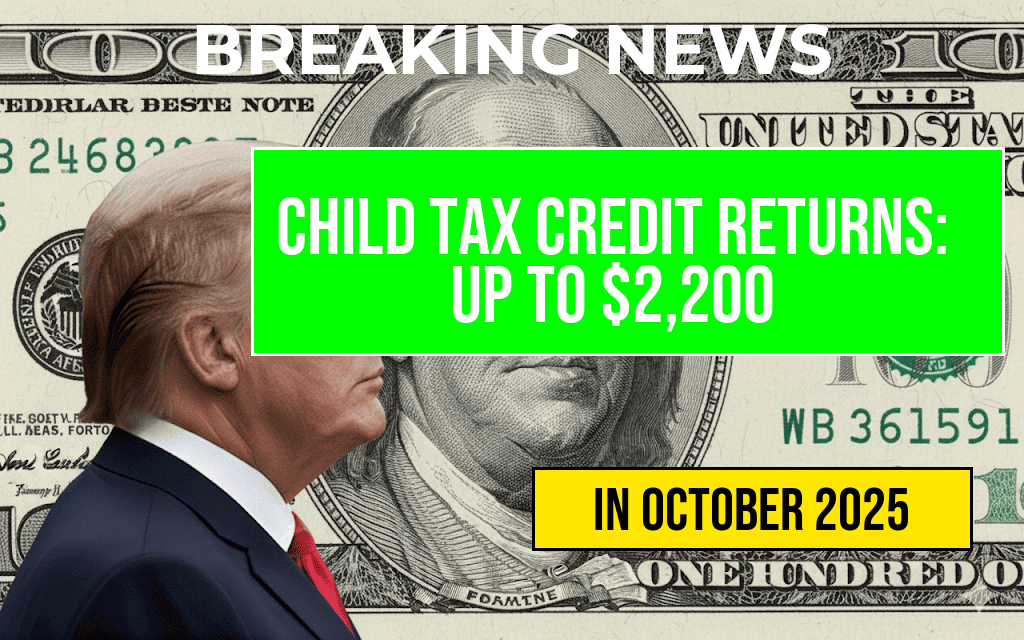The upcoming tax year will see a significant boost in child-related financial relief for American families, as the Child Tax Credit (CTC) returns to expanded levels introduced during the pandemic-era relief efforts. Eligible parents and guardians can potentially claim up to $2,200 per qualified child, marking a substantial increase from previous years. This adjustment aims to provide more substantial support to households navigating rising living costs, especially for those with children under 17. The revamped credit structure includes both increased maximum amounts and expanded eligibility criteria, making it a critical component of many families’ financial planning for 2024. The Internal Revenue Service (IRS) is expected to implement streamlined processes to facilitate claims, and experts anticipate widespread awareness campaigns to ensure eligible households are informed of their benefits. With the new tax provisions, millions of families could see significant improvements in their annual refunds or reductions in tax liabilities, reinforcing the government’s focus on child welfare and economic stability.
Expanded Child Tax Credit for 2024
What Changes Are Coming?
The Child Tax Credit, historically a pivotal part of federal tax policy aimed at alleviating child-related expenses, has undergone notable modifications for the upcoming tax year. These updates stem from legislative actions designed to support economic recovery and reduce child poverty. Key changes include an increased maximum credit amount, broader eligibility parameters, and simplified claim procedures.
Maximum Benefits and Eligibility
| Feature | Details |
|---|---|
| Maximum Credit per Child | $2,200 |
| Age Range for Eligibility | Under 17 at the end of 2024 |
| Income Threshold for Full Credit | Single filers: up to $75,000; Married filing jointly: up to $150,000 |
| Phase-Out Rate | $50 for every $1,000 earned above the threshold |
Previously, the maximum credit was $2,000 per child, with a phase-out beginning at lower income levels. The new structure raises the cap and adjusts income limits, making the credit accessible to more middle-income families.
How to Claim the Child Tax Credit
Taxpayers should ensure they have accurate documentation, including proof of the child’s age and relationship, such as birth certificates or guardianship papers. The IRS recommends reviewing the official Child Tax Credit guidelines to verify eligibility and claim procedures.
Most families will claim the credit when submitting their annual federal tax return, either via standard filing methods or through electronic filing platforms. The IRS has committed to providing clear instructions and support to assist filers in maximizing their benefits.
Implications for Families and the Economy
Support for Childcare and Household Expenses
The increase in the Child Tax Credit can significantly reduce the financial burden associated with raising children. For many families, the additional funds can cover essentials such as childcare, education supplies, healthcare, and nutritious food. Experts suggest that these benefits not only improve immediate household stability but also contribute to long-term child development outcomes.
Broader Economic Impact
Financial relief programs like the Child Tax Credit are viewed as vital tools for addressing economic inequality. By providing direct support to working-class families, policymakers aim to stimulate consumer spending and support local economies. Studies have shown that expanded tax credits have historically correlated with reductions in child poverty rates and improved educational and health metrics among children.
Additional Resources and Considerations
- For detailed information about eligibility and claiming procedures, visit the IRS Child Tax Credit page.
- Families with complex situations or those unsure about their eligibility may seek guidance from tax professionals or community assistance programs.
- It’s advisable to review recent updates from the legislative sources to understand the legislative context of these changes.
As the 2024 tax season approaches, awareness of these enhancements can help families plan accordingly and ensure they receive the maximum support available. The refreshed Child Tax Credit underscores the government’s ongoing commitment to supporting families and fostering economic resilience across diverse communities.
Frequently Asked Questions
What is the Child Tax Credit for next year?
The Child Tax Credit for next year allows families to receive up to $2,200 per qualified child, providing significant financial support to help with child-related expenses.
Who qualifies as a qualified child for the Child Tax Credit?
A qualified child typically must be under 17 years old, be a U.S. citizen, depend on the taxpayer, and meet other criteria related to residency and relationship.
How do I claim the Child Tax Credit on my tax return?
You can claim the Child Tax Credit by filing your tax return and completing the appropriate Schedule 8812. Ensure you meet all eligibility requirements and include the child’s information accurately.
Are there income limits for receiving the full Child Tax Credit?
Yes, the Child Tax Credit begins to phase out at higher income levels. The exact limits depend on your filing status, but generally, higher income families may receive a reduced credit amount.
Can I receive the Child Tax Credit if I received advance payments last year?
Yes, but you need to reconcile any advance Child Tax Credit payments received with your total credit amount when filing your tax return. Failure to do so may affect your eligibility for the full credit.










